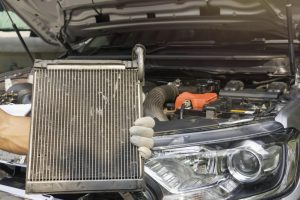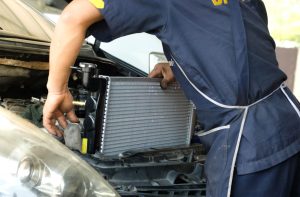Your car’s radiator is a vital component of the cooling system, responsible for regulating engine temperature and preventing overheating. When the radiator starts to fail, the symptoms can range from minor annoyances to serious mechanical issues that threaten your engine’s health. Catching the signs early can save you time, money, and a potentially costly breakdown.
In this article, we’ll break down the most common signs of a failing radiator, the reasons behind them, what to listen for, and how to respond before it’s too late.

Why the Radiator Matters
The radiator helps dissipate heat from the engine by circulating coolant through its core and using airflow (or fans) to cool it before sending it back. If the radiator isn’t working correctly, engine temperatures can skyrocket, leading to potential engine damage.
Common Symptoms of Radiator Failure
Here’s a breakdown of key warning signs and what they may indicate:
| Symptom | Possible Cause | Action to Take |
|---|---|---|
| Engine overheating | Blocked, leaking, or clogged radiator | Inspect radiator, coolant level |
| Low coolant levels | Leaks in the radiator or hoses | Check for puddles under the car |
| Discolored or sludgy coolant | Internal corrosion or oil contamination | Flush coolant, inspect for gasket failure |
| Visible rust or green residue | Leaking seams or degraded metal | Inspect for cracks and rust buildup |
| Frequent need to refill coolant | Slow leak or internal damage | Pressure test the system |
| Coolant puddle under vehicle | Radiator crack or hose failure | Locate and repair the source |
| Steam from the hood | Overheating radiator | Pull over immediately, let engine cool |
| Heater not blowing warm air | Coolant flow issue due to radiator blockage | Flush the system |
| High-temperature gauge readings | Ineffective heat dissipation | Inspect thermostat and radiator |
Sounds That May Signal Trouble
Sometimes, your ears can catch problems before your eyes do.
-
Gurgling sound: Air pockets in the coolant system due to a leak or low fluid.
-
Hissing noise: Steam escaping from a leak, especially under pressure.
-
Clicking or tapping: Could indicate an overheating engine due to cooling failure.
Visual Signs of Radiator Damage
-
Cracks or Holes: Often found on plastic tanks or metal seams.
-
Discoloration: Dried coolant can leave green, white, or rust-colored stains.
-
Bulging Radiator Hoses: Excess heat and pressure weaken the rubber.
-
Damaged Fins: External debris can bend or clog cooling fins, reducing efficiency.
Diagnosing the Problem
Use this quick checklist to determine whether your radiator is the issue:
Radiator Failure Diagnostic Checklist
| Task | What to Look For |
|---|---|
| Check coolant level | Low fluid may suggest leaks |
| Inspect under the car | Coolant puddles or wet spots |
| Open the radiator cap (cold engine) | Sludge, bubbles, or rust particles |
| Look at temperature gauge | Fluctuating or consistently high readings |
| Check radiator fins | Bent, broken, or clogged with debris |
Don’t Ignore These Warning Signs
Failing to address radiator problems can lead to serious consequences:
-
Head gasket failure
-
Warped engine block
-
Engine seizing due to overheating
-
Poor cabin heating
-
Coolant mixing with oil
DIY Maintenance Tips to Prevent Radiator Issues
-
Flush the coolant system every 2–3 years to remove rust and debris.
-
Use the right coolant mix as recommended by your vehicle’s manufacturer.
-
Check hoses for cracks or leaks and replace if needed.
-
Keep radiator clean by removing dirt, leaves, and bugs from the fins.
-
Inspect the radiator cap — it helps maintain proper system pressure.
Radiator Maintenance Table
| Task | Frequency | Why It Matters |
|---|---|---|
| Coolant flush | Every 2–3 years | Prevents corrosion and buildup |
| Hose inspection | Every oil change | Detects cracks and bulges early |
| Radiator cap check | Yearly | Ensures correct pressure and seal |
| Fin cleaning | Seasonally | Maintains airflow and cooling efficiency |
Is It the Radiator or Something Else?
Sometimes, radiator-like symptoms can stem from other cooling components:
| Component | Common Issue | How It Differs from Radiator Failure |
|---|---|---|
| Thermostat | Stuck closed/open | Inconsistent temperature control |
| Water pump | Worn or leaking seal | Coolant loss, grinding noise |
| Heater core | Clogged or leaking | Sweet smell in cabin, wet floor mats |
| Cooling fan | Not turning on | Overheating only in traffic or idling |
When to Replace Your Radiator

If your radiator is over 8–10 years old, or showing signs of internal corrosion, persistent leaks, or structural damage, it’s time to replace it.
Key signs it’s time to replace:
-
Constant overheating even after flushing
-
Repeated need for coolant top-offs
-
Cracked tanks or visible leaks
-
Radiator fins falling apart
-
Discolored, sludgy coolant reappears quickly
Where to Buy a New Radiator or Parts
Need to replace your radiator, hoses, or pressure cap? Don’t wait for a full engine failure.
Buy Radiator & Components online — explore a wide range of high-quality, OE-spec radiators and cooling system parts suitable for all types of vehicles.
Final Thoughts
The radiator might be out of sight, but it should never be out of mind. Small signs like fluctuating temperature gauges, strange sounds, and disappearing coolant are your car’s way of saying something’s wrong. Routine maintenance and quick responses to the warning signs of radiator failure can prevent engine disasters down the road.
Stay alert, act early — and keep your engine cool, clean, and running strong year-round.